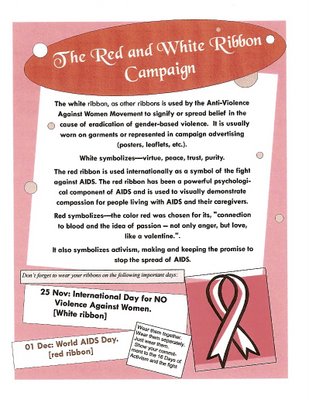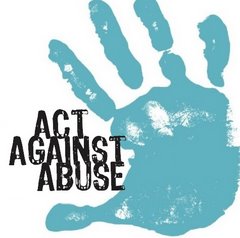 [Please click on the image to enlarge it and read about the Ribbon Campaign]
[Please click on the image to enlarge it and read about the Ribbon Campaign]
16 Days of Activism For No Violence Against Women and Children. Silence is Violence. Act Against Abuse.
 [Please click on the image to enlarge it and read about the Ribbon Campaign]
[Please click on the image to enlarge it and read about the Ribbon Campaign]
 http://www.thebody.com/surveys/sexsurvey.html
http://www.thebody.com/surveys/sexsurvey.htmlThe group identified the following as being challenges in devising and implementing our assignment, and formulated the following strategies to overcome them -
1. Defining our focus and limiting our ideas –
It was difficult for us to define exactly what we wished to achieve and the methods whereby we would do this. This difficulty was encountered as a result of the broad nature of the topic, and the variety of ideas presented by the group. We had to limit ourselves in line with financial and time constraints. Although we managed to raise a substantial amount of money, we then had to decide how to utilize it in a way that would achieve our objectives as cost-effectively and efficiently as possible.
We thus chose to use it to do the following –
- Purchase food, toiletries and other items needed by a number of organizations that assist abused women and children;
- Implement our awareness campaign by buying or making the following –
Posters, flyers, leaflets;
2. Co-ordination and working in a large group -
This proved to be very taxing, as having members from both groups in our year meant that there were many timetable clashes, and not all members were free at the same time. It was difficult to meet up and delegate work and supervise progress of work.
To combat this challenge we drew up Meeting Schedules and Progress Reportswhich dealt with the following –
- Each person’s individual tasks for the week, and progress made and steps to still be taken.
- All other member’s tasks, current progress and further steps to be taken. This was to ensure that everyone in the group knew what all the other members were doing and could check up on each other’s progress and offer assistance where needed.
- A record of items discussed at meetings, so that we could draw further ideas and inspirations and keep a record of the development of our Campaign Plan and our objectives;
- A register of attendance, so that we could keep track of and identify those individuals that needed to be encouraged to work harder, in order to prevent anyone from being inactive and to avoid conflicts over the amount of work being done by individuals. The register also served to identify those persons who made a contribution over and above what was expected. A register also compelled members to attend meetings, failing which they had to excuse themselves beforehand and apologise to the group. It also stated the time, date and place of future meetings – so there could be no confusion in that respect and to avoid wasting time searching for venues and group members.
3. Encouraging people on campus to contribute to our campaign -
At first, we thought to put out posters and email all students and staff with a list of requirements, informing them that they could drop them off at Collection Points around campus, but this proved to be ineffective, although people noticed our posters, emailed in asking where they could drop stuff off, but then the following happened –
- Boxes were stolen or thrown away at the collection points;
- People weren’t interested in making a contribution, or it was too much of a hassle to bring bags of clothing or canned food in to campus to drop off;
- Students at the Westville campus Law Clinic used our posters and our publicity from the emails, collected our contributions and then used them for their own purposes. We had confirmation that they used our posters from Professor Vawda, who remarked that he had seen our poster on Westville campus while lecturing there.
So we dealt with the above-mentioned setbacks by raising funds ourselves in order to purchase what we had hoped students would contribute. We raised these funds in the following ways –
- Soliciting contributions from the lecturers on Campus.This proved to be very effective, and we raised a large portion of our funds in this way;
- Having a cake sale. Although we were at first opposed to this idea, it was relatively easy to organize, execute and raised a fair amount of money.
- Selling our Red and White Ribbons. This raised about a quarter of our total sum, and served a two-fold purpose. Firstly, raising funds, and secondly promoting awareness of our cause and about the 16 Days of Activism in general.
- An intra-group donation scheme was set up, whereby we each contributed money, materials or time and skills as we were each able to. This also proved to be very profitable, and showed our group’s willingness to reach into their own pockets for our cause.
- Emailing various companies, corporations and organizations requesting donations and contributions, and although we received many refusal e-mails in return we did manage to receive a donation from Pick ‘n Pay. Although Lil-Lets was willing to donate a number of sanitary products, it proved too difficult to organize the delivery in time for our presentation.
- Our personal contacts were utilised to their full extent, in this respect we achieved the following –
 In line with the theme of 'speaking out' we'd like to know your answers to any of the following: (your responses can be anonymous if you wish)
In line with the theme of 'speaking out' we'd like to know your answers to any of the following: (your responses can be anonymous if you wish)You can get a protection order to stop any of these kinds of domestic violence from happening to you. Remember: a protection order is a special kind of interdict or court order to protect you in domestic violence cases.
HOW DO YOU GET A PROTECTION ORDER? GUIDELINES:

What are the different stages of HIV?:
HIV causes disease by the progressive destruction of the immune cells which it infects. These are the CD4 cells which are central to maintaining and measuring a healthy immune system. Without a strong immune system, we become vulnerable to opportunistic infections and cancers which normally we could fight off easily.
We call these infections ‘opportunistic’ because HIV gives these germs an opportunity to cause disease.
The 5 stages of HIV disease:
1.Primary HIV infection
2.The asymptomatic or ‘silent’ stage
3.Early HIV symptomatic disease
4.Medium-stage HIV symptomatic disease
5.Late-stage HIV symptomatic disease (AIDS).
PRIMARY HIV INFECTION
This happens within a few weeks of HIV infection and is the time when people sero-convert on their blood test for HIV – in other words, change from being HIV negative to HIV positive.
About half of people infected will develop a flu-like illness with fever, sore throat, swollen glands, headache, muscle aches and sometimes a rash. This stage of HIV disease lasts only a week or two – after this, you return to feeling and looking completely well.
THE ASYMPTOMATIC OR ‘SILENT’ STAGE
After recovery from the primary HIV illness, people infected with HIV continue to be completely well for long periods, often for many years. During this time, the only indication that you are infected with HIV is that you will test positive on standard HIV tests and you may have swollen lymph glands.
This means that you look and feel healthy and can easily infect other people through unprotected sex – especially if you do not know that you are infected.
But HIV is still very active and is continuing to destroy the immune system at this stage.
EARLY HIV SYMPTOMATIC DISEASE
Several years after infection, some people will begin to show mild symptoms of HIV disease. These can include:
Shingles
Swollen lymph glands
Occasional fevers
Mild skin irritations and rashes
Fungal skin and nail infections
Mouth ulcers
Chest infections
Weight loss.
MEDIUM-STAGE HIV SYMPTOMATIC DISEASE
This stage of HIV disease was once known as ‘AIDS-related complex’. This is when people with HIV can become quite ill without developing the ‘AIDS-defining illnesses’. Typical problems include:
Tuberculosis
Recurrent oral or vaginal thrush (a fungal rash or spots)
Recurrent herpes blisters on the mouth (‘cold sores’) or genitals
Ongoing fevers
Persistent diarrhoea
Significant weight loss (more than 10%).
LATE-STAGE HIV DISEASE (AIDS)
Without effective treatment, the long-term damage caused to the immune system by HIV results in severe opportunistic infections, cancers and HIV-related damage to other organs (eg the brain). This stage is usually called ‘AIDS’.
People with severe HIV disease can experience many illnesses at the same time. Many of these infections can be prevented with antibiotic treatment if you test and become aware of your HIV status at an earlier stage. These AIDS-defining illnesses include:
Severe diarrhoea
Severe weight loss
Severe pneumonia
Brain infections
Confusion and memory loss
Severe skin rashes
Pain and difficulty swallowing.
Summary of the stages of HIV:
PRIMARY HIV INFECTION: Flu-like illness HIV test becomes positive
SILENT STAGE:People look and feel healthy. Swollen lymph glands.HIV still active
EARLY HIV SYMPTOMATIC DISEASE: Shingles; occasional fevers; mild skin irritations and rashes; weight loss.
MEDIUM-STAGE HIV SYMPTOMATIC DISEASE:Tuberculosis, oral or vaginal thrush;‘cold sores’ or genital herpes; ongoing fevers; diarrhoea and weight loss.
LATE-STAGE HIV DISEASE (USUALLY CALLED AIDS)Severe diarrhoea.Severe weight loss. Severe pneumonia. Brain infections. Confusion and memory loss. Severe skin rashes. Pain and difficulty swallowing.
References -
http://www.kalrahospital.net/aids-awareness.html
http://www.alp.org.za/modules.php?op=modload&name=News&file=article&sid=14

 Violence against women is traumatic to the body, mind and spirit and can prevent women from participating to the full extent of their potential in the workplace and at home, and in society in general.
Violence against women is traumatic to the body, mind and spirit and can prevent women from participating to the full extent of their potential in the workplace and at home, and in society in general. 

